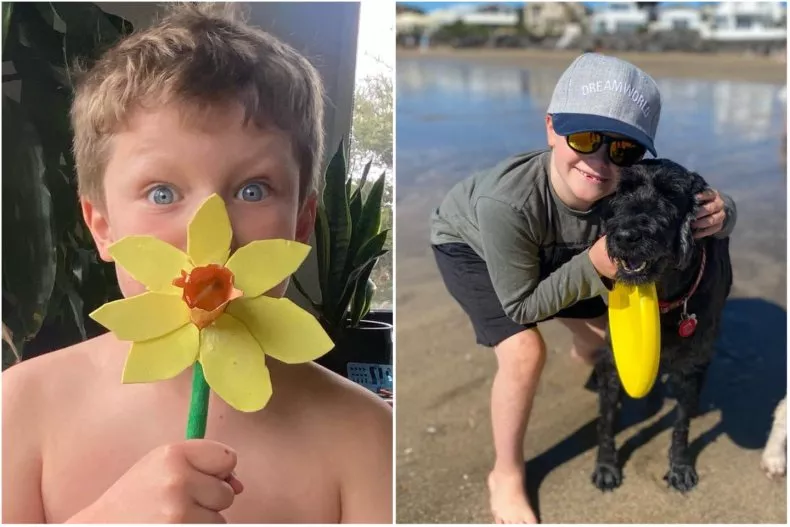An otherwise healthy 8-year-old boy, Lachie Love, who loves swimming, climbing trees, football, and music, was diagnosed with a rare and incurable type of brain cancer just a week after he developed a squint in his left eye. Lachie, from Auckland, New Zealand, was confirmed to have DIPG, a type of brain tumor, on December 29. DIPG is a rare and aggressive form of cancer that mostly affects children between the ages of 5 and 7. It is estimated that there are around 150-300 new diagnoses of DIPG every year in the United States.
Earlier to being diagnosed, Lachie remained active and healthy, with only minor health difficulties, according to his mother, Liesje Love. There had never been any concerns about his health. Such issues had never occurred to them. They've been quite fortunate in terms of a family following the Newsweek report.
Liesje, with her husband, Andy, saw their son's left eye squinting the week before Christmas. The next day, the eye had begun to turn in slightly, like such a lazy eye, according to Liesje. They visited an ophthalmologist the next day, and it was determined that he had some visual problems that had occurred on December 23rd.
From Squint to Cancer
A squint, also known as strabismus, occurs when the eyes do not line properly. Strabismus can be either continuous or intermittent. This is mainly due to the extraocular muscles, which govern the eye's motion, and the eyelid not cooperating. Practically, both eyes cannot focus on the same object simultaneously. It can also occur as a result of a brain injury or condition that impairs the capacity of the eyes to operate together. Constant strabismus renders binocular vision difficult, resulting in a loss of depth awareness, as stated by Medical News Today.
Lachie was directed to a professional eye facility for additional testing four days later by the optometrist. Liesje began to fear that the condition was more than just an eye problem. Lachie explained their experience in psychology had led me to suspect that a different thing was going on.
They were granted a consultation at pediatric outpatient clinics on the 29th at 10:00 am and were transferred to Starship Children's Hospital's Emergency Department after around two hours. They performed a CT scan without contrast since Lachie was afraid of needles, and it revealed a mass around the Pons. The pons is a region of the brainstem that controls several vital biological activities, such as breathing, sleeping, bladder control, and balance. Their son was hospitalized, and the following day Lachie could have an MRI under local anesthetic, at which point they decided to take a biopsy, which, while somewhat dangerous, was appropriate given the position of the lump, according to Liesje.

Lachie Love is an eight-year-old boy from Auckland with "a sparkle in his eye and an overflowing personality." He has been diagnosed with a rare form of brain cancer.
ALSO READ: Ophthalmologists May Skip Anesthesia Support During Cataract Surgery [STUDY]
DIPG Targeting Children
The "egg" was identified as DIPG. There isn't any known treatment for DIPG, and no chemotherapeutic medicines have been shown to improve survival rates. Because of the tumor's position in the brain stem, the operation is not an option because the neighboring, healthy tissue is critical for survival. As a result of this paucity of treatment choices and the violent nature of the illness, less than 10% of adolescents survive two years after their diagnosis. Lachie has no idea how serious his diagnosis is, and he and his younger brother, Harry, became worried about their mother crying in the hospital.
According to cancer.org, an uncommon, rapidly growing tumor develops in glial cells in the pons region of the brain stem. DIPGs are difficult to treat and have a bad prognosis because they spread to adjacent tissue and other areas of the brain stem (outcome). They are more common among children. Diffuse intrinsic pontine glioma is another name for this type of tumor. DIPG is classified as a "high grade" malignant brain tumor due to its placement in the brain and fast progression.
Lachie will be equipped with a radiological mask on January 11, and therapy will begin within a few weeks. He will subsequently get six months of outpatient radiation therapy before having the region re-scanned. According to DIPG.org, radiotherapy is an efficient palliative treatment that reduces symptoms in around 80% of children with the illness. However, these enhancements are just transitory. As a solution, Liesje's sister, Nikki Donkin, has put up a Give a Little website to generate cash for Lachie's therapy and to help him cross items off his "bucket list" while he can.
RELATED ARTICLE: Girl Suffering From A Rare Bone Marrow Disease Raises Hope Through Zumba
Check out more news and information on Medicine and Health in Science Times.














